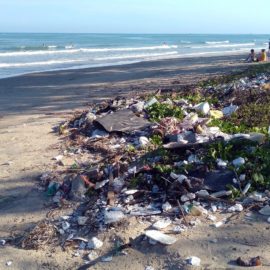
NOAA National Centers for Coastal Ocean Science
The green on the map above is algae. It is potentially harmful but not a health threat, yet.
Blooms of potentially harmful algae have swirled in lakes Pontchartrain and Maurepas during most of the summer of 2021, spurred by increased inflow of phosphorus and other nutrients caused by this year’s heavy rainfall, according to scientists monitoring the blooms. The concentration of cyanobacteria, or blue-green algae, this year has not resulted in health warnings from the Louisiana Departments of Environmental Quality or Health, and the Louisiana Department of Wildlife and Fisheries has not issued any reports of effects on fisheries. “EPA has conducted testing and toxin levels are well below limits,” said Mindy Faciane, a spokeswoman for the health department. “We are monitoring and plan to conduct some testing of our own soon for toxins produced by algae.
nola.com
The Louisiana Wildlife and Fisheries is also watching this occurrence and thinking of past times the lake was closed.
A spokesman for Wildlife & Fisheries said the agency won’t know what impact this year’s bloom might have on fisheries until it’s over and can be compared to past events. “We would speculate that there is far less coverage than the algal bloom we experienced last summer after the prior spillway opening, and we did not have any reported effects from that lake-wide algal bloom,” said spokesman Rene LeBreton. The last time health warnings were issued for algae blooms in the lake was in 2019, when the Bonnet Carre Spillway was open for a record 123 days, funneling nutrient-rich Mississippi River water into Lake Pontchartrain. In June and July of that year, Wildlife and Fisheries and the health department warned those on the water to avoid the blue-green algae, which can cause rashes, stomach cramps, nausea, diarrhea and vomiting. The health department also advised against harvesting or eating fish taken from the lake during the bloom.
It could be this sighting is because of new tecnology being used to scan the Gulf of Mexico to find algae blooms there.
The reemergence of the algae issue is in part the result is in part the result of new technology being used by NOAA to track harmful algae blooms in the Gulf of Mexico, and especially their efforts to track blooms of a different strain of algae, Karenia brevis, or red tide, off the central Florida Gulf Coast. Health warnings have been posted in numerous locations along that stretch of Florida coastline for much of the spring and summer. In April, blooms in that area were exacerbated by the release of phosphorus-rich wastewater from a phosphogypsum pile at a closed fertilizer manufacturing facility in Manatee County to portions of Tampa Bay. Louisiana is included in the satellite surveillance in part because of the repeated openings of the spillway, which have often fed large blooms of algae.
We also have had a lot of rain which has caused more runoffs into the lake.
This year, the problem is the unusual number of intense rainfall events, which pick up nutrients from individual home sewage treatment systems, cattle farms and other types of agricultural operations, and from natural sources within the watersheds of a half-dozen rivers and bayous that feed into lakes Maurepas and Pontchartrain. The total rainfall recorded by mid-August at both Louis Armstrong New Orleans International Airport and Ryan Baton Rouge Airport already matched the annual average.
The Corps of Engineers is also involved as some of their actions may have helped cause these blooms.
Researchers with the Army Corps of Engineers are also investigating whether the closure of the Mississippi River-Gulf Outlet and construction of the Lake Borgne Surge Barrier have significantly reduced salinity levels in the western part of Lake Pontchartrain and adjacent Lake Maurepas, which also produces conditions beneficial to algae growth, said Eric Glisch, an environmental engineer with the Corps’ New Orleans district office. Glisch has overseen Corps monitoring of nutrients in the lake in recent years when the spillway, a Corps-controlled flood control project, is opened.“From reviewing satellite imagery for evidence of blooms, it looks like the Amite River (the largest tributary to the Pontchartrain estuary, not including the Pearl River) is often the primary source for blooms, which can begin in Lake Maurepas and migrate through Pass Manchac to the northwest/north part of Lake Pontchatrain, where they tend to fester,” Glisch said. “The Tangipahoa (river) is the second largest tributary, and is located in the part of Lake Pontchartrain where blooms typically occur. Presumably, there’s an overlap of inflows from Pass Manchac and the Tangipahoa contributing to the blooms in that part of Lake Pontchartrain.”
Satellite imagery is being used to track the spread of the algae and to make other determination on what comes next.
A Sunday satellite image shows the greatest concentrations in Lake Pontchartrain are near the north shore shoreline, with lesser concentrations along the western edge and middle of the lake and smaller amounts along the shoreline east of Lakefront Airport. Moderate concentrations show up along the northern shoreline of Lake Maurepas, completely filling Lac des Allemands on the west bank, and filling most open-water areas within the wetlands in the drainage area of the Caernarvon Spillway. John White, an oceanography and coastal sciences professor at Louisiana State University who has been studying water quality and algal blooms in Lake Pontchartrain since the spillway was opened in 2008, said his team also hasn’t completed its assessment of this year’s bloom. “But anecdotally, the water samples we are filtering are ‘greener’ than we have seen in over a decade,” he said. “We seem to see larger algal blooms in years where the north shore river discharge is high, due to higher precipitation, as this water is the primary source of nutrients which feed the algae in years when the spillway is closed, as it is this year,” White said. “While in the past, the algae blooms have been more patchy, we are seeing high algae consistently all across the western half of the lake.”
The spillway sseems to be in the list of problems by many. It brings silt and that can enrich the lake.
In comparison, in years when the spillway is open, the spillway water is turbid, or brown with the sediment carried by the Mississippi River. That blocks light, and in turn blocks fast growth of the algae, even though it may have more than enough nutrients. “The lake is not turbid during the closed years, and with nutrients from the north shore watershed, the algae is thriving,” he said. The flow from the spillway also moves more quickly through the lake than flow from the north shore, resulting in the nutrients being in the lake and available to algae longer, said Sibel Bargu Ates, a professor of oceanography and wetland studies at LSU, who has been working with White on the lake’s algae issues.
Least we not forget, it is also hot!
Warm temperatures without tropical storms or hurricanes also contribute to the lake’s algae growth, while winds that do play across the lake have helped move the algae across a larger part of its surface this year, she said.
With all these contributors it is no wonder the lake has algae!



